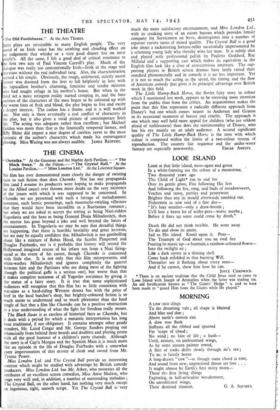THE CINEMA
" Chetniks." At the Gaumont and the Marble Arch Pavilion. " The Black Swan." At the Odeon.--" The Crystal Ball." At the London Pavilion.—" Miss London Ltd." At the Leicester Square.
No film has ever demonstrated more clearly the danger of twisting facts to suit fiction than does Chetniks. Nor has any propaganda film (and I assume its producers were hoping to make propaganda for the Allied cause) ever thrown more doubt on the very existence of the issues with which it was supposed to be concerned. In Chetniks we are presented with such a farrago of melodramatic nonsense, such heroic posturings, such moustache-twirling villainies that they would have been incredible in a Ruritanian romance ; but when we are asked to accept the setting as being Nazi-ridden Yugoslavia and the hero as being General Draja Mihailovitch, then the matter has gone beyond a joke and well beyond the limits of entertainment. In Yugoslavia we may be sure that dreadful things are happening, that there is horrible bestiality and great heroism, but we may be equally confident that Mihailovitch is not gambolling about like a mixture of Robin Hood, the Scarlet Pimpernel and Douglas Fairbanks, nor is it probable that history will record the Hollywood imagined rescue of his infant son from a Nazi firing- squad as the event of his career, though Chaniks is concerned with little else. It is not only that this film misrepresents and white-washes Mihailovitch and ignores completely the quarrel between him and the Partisans who are doing most of the fighting (though the political gaffe is a serious one), but worse than that it makes complete nonsense of all Yugoslav resistance by giving it the status of a fairy story. It is true that some sophisticated audiences will recognise that this film has as little connexion with war-aims as a hard-riding Western drama has with the price of beef in the local butcher's shop, but brightly-coloured fiction is so much easier to understand and so much pleasanter than the hard tangle of fact that a film like Chetniks can be a positive obstruction to a true understanding of what the fight for freedom really means.
The Black Swan is as careless of historical facts as Chetniks, but it deals with a period for which a romantic interpretation has long been traditional, if not obligatory. It contains amongst other gaudy wonders, Mr. Laird Cregar and Mr. George Sanders peeping out whimsically from behind their beards and doublets and playing pirate with all the good humour of a children's party charade. Although the story is of Cap'n Morgan and the Spanish Main ids much more like an episode in the life of Douglas Fairbanks with a somewhat puny impersonation of that master of cloak and sword from Mr. Tyrone Power.
Miss London Ltd. and The Crystal Ball provide an interesting contrast which might be studied with advantage by British comedy producers. Miss London Ltd. has Mr. Askey, who possesses all the attributes of an excellent screen comedian, Miss Anne Shelton, who sings very well and, in addition, a number of outstanding melodies ; The Crystal Ball, on the other hand, has nothing very much except an ingenious, tight, smooth script. Yet The Crystal Ball is' very much the more satisfactory entertainment, and Miss London Ltd., with its creaking story of an escort bureau which provides female company for Servicemen on leave, disintegrates into a number of separate variety turns of mixed quality. The Crystal Ball is a good joke about a racketeering fortune-teller successfully impersonated by a scheming young lady who thereby wins her man. It is subtly shot and played with professional polish by Paulette Goddard, Ray Milland and a supporting cast which makes its equivalent in the English film look like a class of conscientious amateurs. The sup- porting players in British screen dramas have lately raised their standard phenomenally and in comedy it is no less important. Yet it is not so much the acting as the speed, the timing and the flow of American comedy chat gives it its principal advantage over British work in this field.
The Little Hump-Back Horse, the Soviet fairy story in colour which I mentioned last week, appears to be receiving more attention from the public than from the critics. An acquaintance makes the point that this film represents a radically different approach from Disney's but one which comes nearer to Andersen and Grimm in its occasional moments of horror and cruelty. The approach is one which may well hold more appeal for children (who are seldom afraid of ruthlessness) than does the sentimentality of Disney, who has his eye mainly on an adult audience. A second significant quality of The Little Hump-Back Horse is the taste with which colour is composed within the limits of a two-colour system of reproduction. The country fair sequence and the under-water fantasy are especially noteworthy. EDGAR ANSTEY.


























 Previous page
Previous page